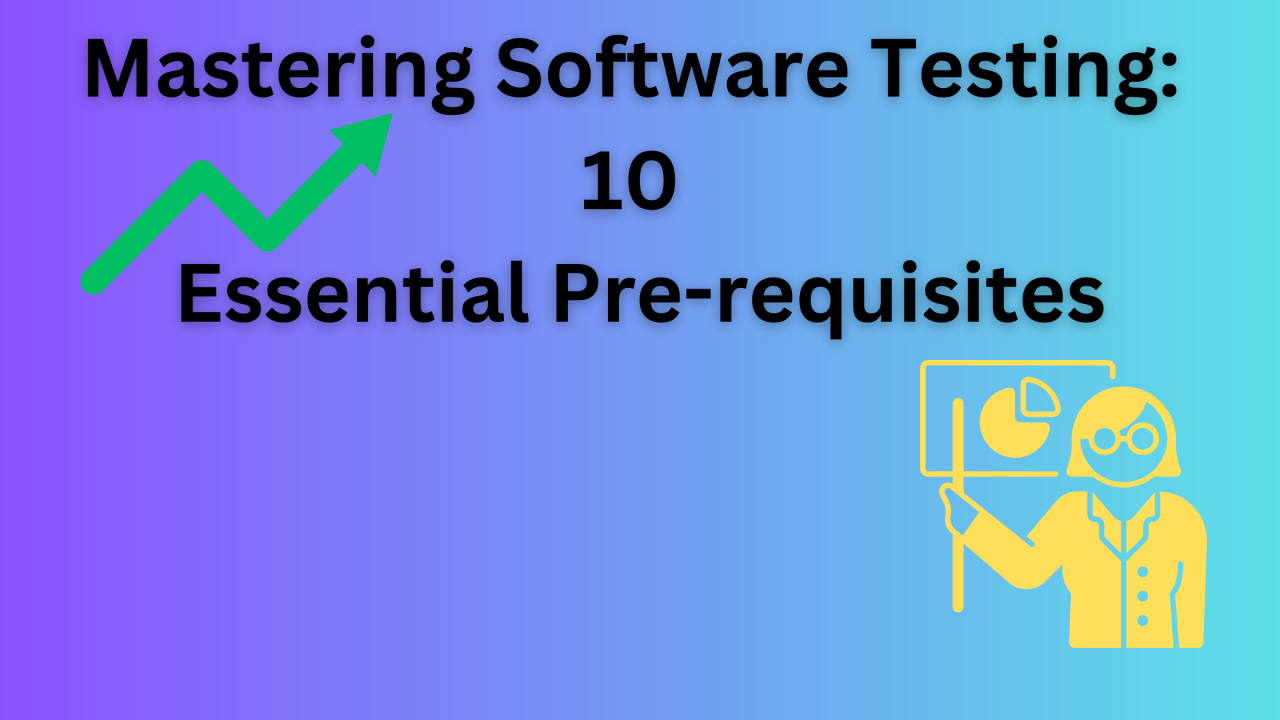
Mastering Software Testing: 10 Essential Pre-requisites
Hi All,
Today, I will explain about some essential pre-requisites before you start testing.
As a professional tester you play critical role in ensuring the quality and functionality of the products you deliver. It will add value to users.
Testing is not just running a few test cases.
It is much more.
Testing demands comprehensive knowledge and thorough preparation.
Today, I present you with an valuable list of ten essential factors to consider before you start testing.
Let’s dive in.
1. Understand the Software Development Process & Methodology:
You need to understand the Software Development Lifecycle (SDLC) and the methodologies applied in your organization-specifically in your team. It is fundamental.
Without this knowledge, it is difficult for you to perform well.
Familiarize yourself with Agile, Waterfall, or any other approach followed to align your testing strategy effectively.
Understanding the SDLC adopted helps you to plan testing, manage risks among other things.
2. Collaboration with Stakeholders:
Testing is not an isolated activity.
It requires active collaboration with stakeholders-fellow testers, developers, designers, UI/UX team, product managers, customer support, IT teams etc.
You need to understand who are the right stake holders.
This helps to ensure a shared understanding of project goals.
When in doubt, you can approach them for clarification.
?? Tip : Effective communication=Half the battle won !
3. Different Types of Testing & Their Purposes:
Testing has various types, each serving a specific purpose. From unit testing to regression testing, be well-versed in different testing types and their roles in the development process.
Understand what is Smoke, Sanity, Regression, Integration testing. This is the foundation.
Know when to start Smoke, how to plan Regression testing etc.
4. Defect Management & Reporting Process:
Know how to report and manage defects efficiently .
This is essential for a successful testing process.
Familiarize yourself with the defect tracking system and the steps to document, prioritize, and resolve issues.
Understanding the Defect Life Cycle is important too.
Take out some time and study how a defect passes through different statuses. When in doubt, ask
Learn the best practices in defect reporting and tracking.
5. Grasping User Requirements & Success Criteria:
To deliver a product that meets user expectations, you must comprehend user requirements and success criteria.
Often times, many requirements are unspecified.
Think from the user point of view and test.
Know the regulatory requirements.
This understanding will guide your testing efforts and ensure customer delight.
领英推荐
Note : Jira is a great tool to document user requirements and acceptance criteria.
6. Tools & Technologies Required:
Tool are required for testing. They are needed for Test management, defect management, automation, etc.
Explore and become proficient in the testing tools and technologies used in your organization. Automation tools, test management systems and other utilities can significantly enhance your testing efficiency.
Note : Tools like Jira, Selenium, Appium, Karate , Micro Focus ALM are some of widely used tools.
7. Goals & Objectives of the Product:
Goals are important for individual, product, business, for growth.
Know what the product goals, company goals.
Then, align your testing approach with the overall goals and objectives of the product.
Understanding the product's purpose and vision will help you prioritize testing efforts and deliver value.
8. Know Users & Their Needs:
Think from user’s angle.
Without knowing user personas, their needs can be a useless testing effort.
Therefore, consider the end-users while testing.
Understanding their needs, preferences and pain points will enable you to perform user-centric testing.
This can lead to a better user experience.
You delight customers and acquire more.
9. Test Data Management:
Test data plays a vital role in executing meaningful test cases.
Ensure you have access to relevant and diverse test data to simulate real-world scenarios effectively.
Most of the times dummy data can be used while testing. But not all times.
Check if you need real time data like Credit cards, etc for testing.
?? Tip : Make sure that you use actual data diligently. Delete all data once testing is done.
10. Test Plan & Approach:
Know what is the plan.
If you don’t have access to the Test plan document, ask it.
A well-defined test plan and approach act as a roadmap for your testing activities.
If Test plan is not done, I suggest to develop a comprehensive plan outlining the scope, objectives, and timelines of testing.
?? Tip : You can proactively offer support to your Team Lead/Manager to prepare Test Plan. This greatly helps in your career growth
Conclusion
Testing is not just test case execution.
Successful testing demands more than just technical knowledge too. It requires a holistic understanding of the development process, stakeholder collaboration and user-centricity.
Armed with these ten indispensable insights, you will be better equipped to ensure product quality and contribute significantly to your product’s success.
Happy testing!
Please do let me know for any further information on this.
P.s: Subscribe to my newsletter to learn more on Software testing !
Testing | Let's Grow | 19 Years of testing service
1 年?? BONUS : Ask the question 'why?'. Why are they building the product? What problem is it solving for user ?
Sales Associate at American Airlines
1 年I think this is a great opportunity